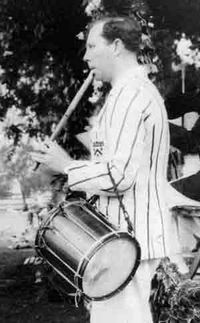Annotation:March Past: Difference between revisions
(Created page with "=='''Back to [[{{BASEPAGENAME}}]]'''== ---- <p><font face="garamond, serif" size="4"> '''MARCH PAST'''. AKA and see "Din Tarrant's (6)," "Wha Saw the Forty Twa," "[[Wh...") |
m (Text replacement - "garamond, serif" to "sans-serif") |
||
| (3 intermediate revisions by 2 users not shown) | |||
| Line 1: | Line 1: | ||
=='''Back to [[{{BASEPAGENAME}}]]'''== | =='''Back to [[{{BASEPAGENAME}}]]'''== | ||
---- | ---- | ||
<p><font face=" | <p><font face="sans-serif" size="4"> | ||
'''MARCH PAST'''. AKA and see "[[Din Tarrant's (6)]]," "[[Wha Saw the Forty Twa]]," "[[Wha Saw the Forty Second?]]," "[[Wha Wadna Fecht for Charlie?]]," Scottish, March. John Kirkpatrick identifies the tune as Scottish, used there as a march or strathspey. The melody is also played in Ireland as a polka. It was picked up by morris dancers in the Cotswold village of Eynsham, Oxon, | '''MARCH PAST'''. AKA and see "[[Din Tarrant's (6)]]," "[[Wha Saw the Forty Twa]]," "[[Wha Saw the Forty Second?]]," "[[Wha Wadna Fecht for Charlie?]]," Scottish, March. John Kirkpatrick identifies the tune as Scottish, used there as a march or strathspey. The melody is also played in Ireland as a polka. It was picked up by morris dancers in the Cotswold village of Eynsham, Oxon, for the dance The Eynsham Morris, for which "March Past" or Nutting We Will Go" was played. The village team impressed collector Cecil Sharp in 1910 with their speed and high kicks, but by 1914 the side had died out, to be revived briefly in 1924–27 and 1937–38. | ||
<br> | <br> | ||
<br> | <br> | ||
</font></p> | </font></p> | ||
<p><font face=" | [[File:Kenworthy.jpg|200px|thumb|left|Kenworthy Schofield (d. 1960)]] | ||
''Source for notated version'': a manuscript by Kenworthy Schofield [Bacon]. | <p><font face="sans-serif" size="4"> | ||
''Source for notated version'': a manuscript by Kenworthy Schofield [Bacon], who mastered both the accordion and the pipe and tabor, and who was a dance leader and teacher. He was a member of the Cambridge Morris Men in the 1920's. | |||
<br> | <br> | ||
<br> | <br> | ||
</font></p> | </font></p> | ||
<p><font face=" | <p><font face="sans-serif" size="4"> | ||
''Printed sources'': Bacon (''' | ''Printed sources'': | ||
Bacon ('''A Handbook of Morris Dances'''), 1974; p. 142. | |||
<br> | <br> | ||
<br> | <br> | ||
</font></p> | </font></p> | ||
<p><font face=" | <p><font face="sans-serif" size="4"> | ||
''Recorded sources'': <font color=teal>Topic TSCD458, John Kirkpatrick | ''Recorded sources'': | ||
<font color=teal> | |||
Topic TSCD458, John Kirkpatrick – "Plain Capers" (1976). | |||
</font> | |||
</font></p> | </font></p> | ||
<br> | <br style="clear:both"/> | ||
<br> | <br> | ||
---- | ---- | ||
=='''Back to [[{{BASEPAGENAME}}]]'''== | =='''Back to [[{{BASEPAGENAME}}]]'''== | ||
Latest revision as of 14:19, 6 May 2019
Back to March Past
MARCH PAST. AKA and see "Din Tarrant's (6)," "Wha Saw the Forty Twa," "Wha Saw the Forty Second?," "Wha Wadna Fecht for Charlie?," Scottish, March. John Kirkpatrick identifies the tune as Scottish, used there as a march or strathspey. The melody is also played in Ireland as a polka. It was picked up by morris dancers in the Cotswold village of Eynsham, Oxon, for the dance The Eynsham Morris, for which "March Past" or Nutting We Will Go" was played. The village team impressed collector Cecil Sharp in 1910 with their speed and high kicks, but by 1914 the side had died out, to be revived briefly in 1924–27 and 1937–38.

Source for notated version: a manuscript by Kenworthy Schofield [Bacon], who mastered both the accordion and the pipe and tabor, and who was a dance leader and teacher. He was a member of the Cambridge Morris Men in the 1920's.
Printed sources:
Bacon (A Handbook of Morris Dances), 1974; p. 142.
Recorded sources: Topic TSCD458, John Kirkpatrick – "Plain Capers" (1976).
